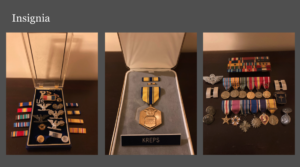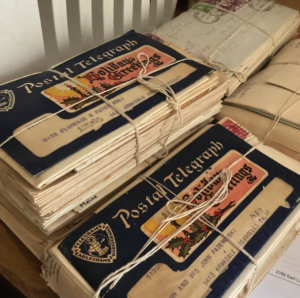Secrets lost to history
For decades, details about Colonel Kenneth Ray Kreps’ illustrious military career — bomber pilot, guerrilla fighter, and high-security air-flight consultant in World War II — remained shrouded in mystery. Relatives knew he’d enlisted in the U.S. Army Air Corps in 1933 after graduating from UCLA with a philosophy degree. They knew about his pilot training as a Flying Cadet and that he was assigned to the 19th Bombardment Group. But that was the extent of it. Like many war veterans, Kreps chose not to share the details of his harrowing combat experience and top-secret assignments in Asia and Europe.
What did he choose to share? The fact that he had a war chest stocked with medals, souvenirs, records, and photographs of his storied career. The contents were incredibly significant as Kreps’ official military records had been destroyed, along with nearly 18 million other military personnel files, in a 1973 fire at the National Personnel Records Center in St. Louis, Mo.
The colonel stipulated that his war chest remain sealed until after his death, and his family honored the request. Kreps retired on Nov. 22, 1963, the day President John F. Kennedy was assassinated, and he lived until the age of 92. After he passed away in 2002 at his home in Rialto, Calif., the war chest was largely forgotten. Before long, the Kreps family lost track of its whereabouts — and the veteran’s legacy.
A conversation left unfinished…

Colonel Kreps kept the secrets of his highly decorated military career close to his chest. (Image courtesy of the Kreps family.)
The colonel’s grandson, Erik Kreps, a financial manager at U-M’s Institute for Social Research, and Erik’s wife, Sandy, BS ’93, recently took up the search after cobbling together some tantalizing clues about his military exploits.
“I grew increasingly curious over the years,” says Erik, who spent endless hours at the Graduate Library, scouring the stacks for information about the WWII Pacific theater, particularly the Philippines campaign.
Only once did the colonel broach the subject with Erik’s father, Kenneth Henry Kreps, who was then a 16-year-old high school student beginning his own military career with the ROTC.
“My grandfather sat my dad down and said, ‘Son, listen closely. I will only tell you things once and never again,’” Erik recalls. “But their conversation was left unfinished after Grandpa became overcome with emotion and could not continue.”

This article from 1946 showcases Kreps (second from left) with fellow military officials during a social outing at Luxembourg Palace. (Image courtesy of the Kreps family.)
Erik’s father later shared some of the war stories he gleaned from that memorable exchange with the elder Kreps.
These accounts included details of how the young airman, who was stationed at Clark Field in the Philippines, witnessed the destruction of the strategic military air base by Japanese fighter planes just hours after the surprise military strike on Pearl Harbor on Dec. 7, 1941.
Following the heavy losses sustained by the American air fleet, Kreps was reassigned to the Philippines, where he fought in the dense jungle side-by-side with the Philippine infantry and carried out gruesome stealth raids on Japanese camps. Later, he served as the personal pilot of Secretary of War Henry L. Stimson from 1942-45 and mingled with high-powered world leaders, including British Prime Minister Winston Churchill, who once gave him a La Corona cigar that the Kreps family still treasures.
But wait, there’s more
In September 2022, Erik and Sandy flew to Riverside, Calif., to visit his father, who had been diagnosed with Alzheimer’s Disease, and stepmother, Christine, who was struggling to care for both her husband and her elderly mother.When the couple inquired about the war chest, they received devastating news.
“My stepmom told us it was gone,” Erik says. “It had been languishing in a storage unit with other family stuff for decades, and she and my dad had stopped making rental payments. The unit had gone into default, and its contents had been put up for auction. I was resigned to the fact that my grandfather’s WWII experiences would remain a mystery forever.”
But to the family’s relief, the storage facility owner told them the auction hadn’t yet happened. All they had to do was pay the unpaid balance on the unit and they could reclaim its contents.
An archive for the ages

The colonel’s M1911 handgun with leather case was stashed in a box, nailed shut, among Colonel Kreps’ belongings. (Image courtesy of the Kreps family.)
With only one day to spare before their return flight to Michigan, the couple scrambled madly to sort through the mountain of dust-encrusted boxes and household castoffs jammed into the storage unit. At last, they located the military foot locker that served as the Kreps war chest.
What they discovered took their breath away.
In the fabled war chest and surrounding boxes, they found military documents, wartime letters that Erik’s grandmother had saved, bundles of yellowed WWII-era newspapers and clipped articles, and binders of flight logs. The colonel’s pilot’s hat and I.D. tags, countless medals and badges, a Japanese dagger, and a wooden box containing a Colt M1911 pistol were just some of the priceless artifacts.
Erik and Sandy spent a sleepless night in their hotel room packing and repacking their treasure-trove of family history into newly purchased oversized suitcases and carry-on bags.
“We don’t own guns and didn’t have the right case for transporting the M1911 pistol,” Sandy says. “We were afraid it would get confiscated by security at LAX.”
The following morning the couple boarded their flight to Detroit. Miraculously, everything they had retrieved from the war chest and storage-unit boxes ― including the pistol and dagger ― made it through airport security and was waiting for them at baggage claim.
Lifting the veil of mystery
Once they were back home in Brighton, Mich., Erik and Sandy faced the monumental task of sorting and categorizing the wartime memorabilia. Over the ensuing months, they gained a newfound appreciation for a remarkable man. Kreps was not only a valiant soldier and trusted military adviser, but also a loving husband and father ― as well as something of a wartime celebrity when he came home on leave.“The contents of the war chest were almost beyond belief,” Erik says. “We learned my grandfather was the recipient of the Silver Star, Purple Heart, Distinguished Flying Cross, Air Medal, Legion of Merit, and Air Force Commendation Medal.”

Packets of correspondence and telegrams, which were discovered in Colonel Kreps’ long-lost war chest. (Image courtesy of the Kreps family.)
Newspaper articles and letters confirmed that Kreps had rubbed shoulders with high-ranking military officials, including General Dwight D. Eisenhower, General George S. Patton, General George C. Marshall, and General Curtis LeMay.
In addition to serving in both the Pacific and European theaters during the war, the colonel later carried out a post-war mission as an Air Attache with the U.S. Army’s Intelligence Division in Ireland. He also maintained an office in the Pentagon, taught at the Air War College in Montgomery, Ala., and advised Congress on the future of air power on the world stage.
Closer to home, Kreps and his wife, Florence Paderewski (the second cousin of the Polish pianist, composer, and statesman Ignacy Jan Paderewski), hobnobbed with Hollywood glitterati. According to one account, “The Kreps were entertained at Romanoff’s in Hollywood by their friends, the Gary Coopers.”
Erik and Sandy were asked to share their findings at a WWII memorial event last year and assembled a slideshow presentation highlighting Kreps’ military and civilian achievements and accolades.
“This journey opened our eyes to a loved one who had all these adventures and yet, remained something of a mystery to us,” Erik says. “Unlocking the secrets of my grandfather’s past made this Memorial Day all that more special.”
(Lead image of Erik and Sandy Kreps by Alex Kreps.)





Allen D’Aoust - 2014
Thank you for sharing your grandfather’s story, he is a true American Hero, not like the loose title that is thrown around in today’s world. It’s people like Colonel Kreps that we need to Thank Every Day for our Freedom.
God Bless the Greatest Generation and Thank You for our Freedom.
Reply
bruce Lanard - 1961
The veterans of WWI and WWII were very hesitant to talk about their experiences and even in my family past military history was never discussed. Colonel Kreps was truly a remarkable man and fortunately the family recovered the secret chest that enabled them to learn of his feats.
Reply